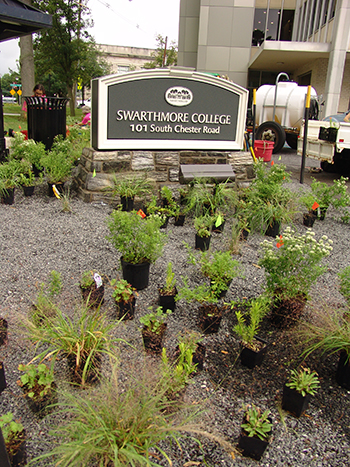
Gravel Gardening: The Planting Formula to Success

In our first discussion of gravel gardens, we discussed a small planting around the Entrance Rock. This planting simply consists of tough plants in gravel, planted deep enough to reach the soil underneath. The inspiration came from the designer, Cassien Schmidt, a German garden designer who has developed naturalistic methods of planting in gravel. Schmidt came to the Scott Arboretum to hold a workshop and also consulted on the traffic circle planting on Chester road. Cassien has developed his way of planting as an easy and efficient formula mostly for municipal plantings and larger, low-maintenance plantings, but it can also be used for the home gardener.
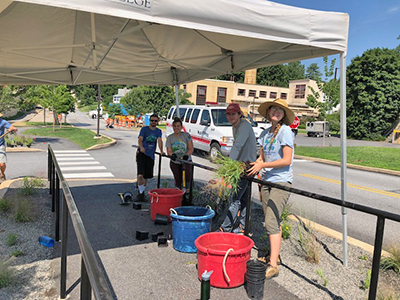
In the last few weeks we have installed a gravel garden around the bus stop in front of 101 Chester Ave., on Fieldhouse Lane, and replanted a gravel garden in front of the PNC bank (a replanting due to construction). photo credit: S. Quinn
After seeing so much success with the traffic circle in just under 2 years after initial planting, the College and Arboretum decided to plant more areas using gravel culture. In the last few weeks we have installed a gravel garden around the bus stop in front of 101 Chester Ave., on Fieldhouse Lane, and replanted a gravel garden in front of the PNC bank (a replanting due to construction). We used Cassien’s formula to create all of these gardens.
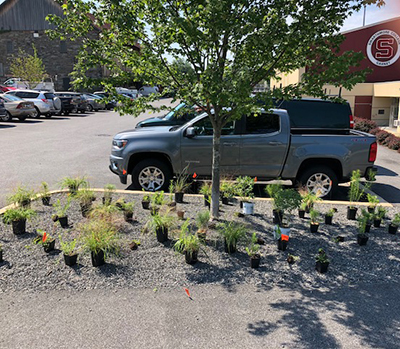
Plants are planted within the grid. photo credit: S. Quinn
First we laid out a grid. Within the grid there is a list of plants and within that list there is a percentage of each type of plant. Different types of plants contribute different benefits to a group planting and act as a community.
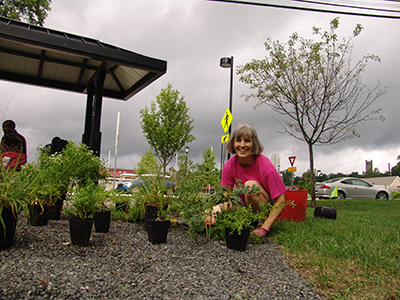
Susan McGinley helping to plant the Chester 101 planting. photo credit: R. Rboert
In this planting there are 5% structural plants, 35% companion plants, 50% ground layer plants, and 10% filler plants. The plants chosen are mostly native and are selected for their ability to live through drought and full exposure to the sun. All of these are perennials but it is possible to incorporate woodies, as we did in the traffic circle.
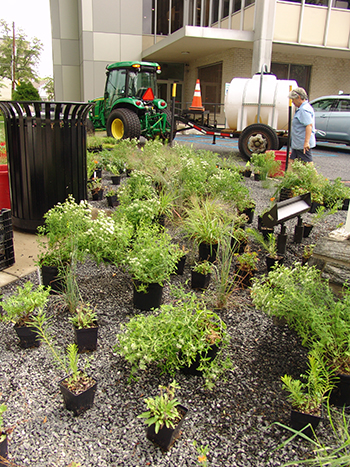
In this planting there are 5% structural plants, 35% companion plants, 50% ground layer plants, and 10% filler plants. photo credit: R. Robert
Within each group of plants there are between 4 and 6 different plants. For example: within the ground layer grouping there are four selections; Geranium cantabrigense ‘Karmina’, Ruellia humilis, Eragrostis spectabilis, and Asclepias tuberosa. In one block, if you need four ground layer plants, you can use one of each.
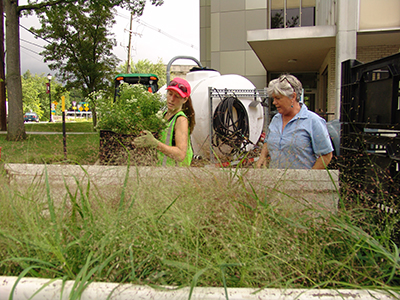
The plants for each block were grouped in crates off-site, then moved to the site and placed in each block of the grid. photo credit: R. Robert
The plants for each block were grouped in crates off-site, then moved to the site and placed in each block of the grid. This made it easy for anyone to take plants out and plant randomly, and random is key. It’s hard sometimes to not think about where you’re placing plants, especially if you’re used to grouping or making swaths. In this planting design, the plants are all meant to grow together and through each other like they would in nature. It’s important to plant densely to cover the ground and inhibit weeds. Although the idea is to plant randomly, it is helpful along paths to plant things that won’t get big and flop over. If you have a narrow strip or an area that someone in a car needs to see over, it is best to leave the taller, structural plants out.
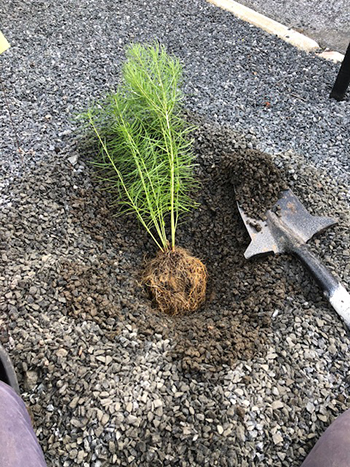
It is important that the roots reach the soil level because they cannot grow out into the gravel. photo credit: S. Quinn
Planting in gravel culture is different. It is important that the roots reach the soil level because they cannot grow out into the gravel. The nutrients or water that most plants need are not present in gravel. In our gravel beds there is 6 inches of gravel above 4 inches of gravel-soil mix. To get to the soil, it takes a bit of digging and it’s important not to get soil in the gravel because that’s where the weed seeds can grow.
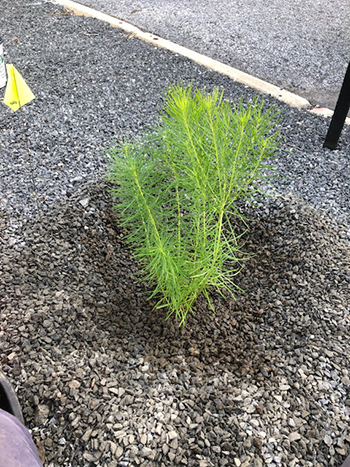
After filling in with the gravel that has been dug out, it seems that you have just dug its grave because it is so deep, but this has been proven to work. photo credit: S. Quinn
I’ve found that a short-handled spade is best for digging. We dug deep, wide holes down to the soil, pulling the gravel layer out wide. It sounds harsh, but each plant gets the soil removed from its roots before it’s planted. Having a bucket close by for soil removal is important to keep soil from falling into the gravel. Removing the soil encourages the plant to go farther down with root growth and discourages weed seeds from growing out of the nursery mix that the plant was in.
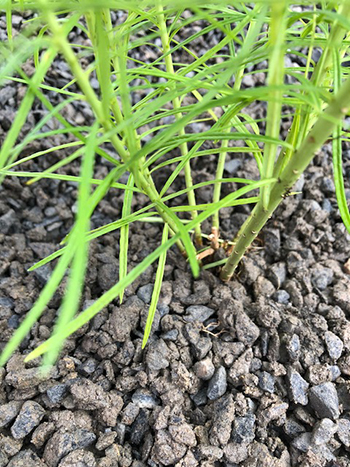
Gravels covers the base of the plant. photo credit: S. Quinn
After filling in with the gravel that has been dug out, it seems that you have just dug its grave because it is so deep, but this has been proven to work. We have had some casualties, but the majority of plants have thrived in this situation.
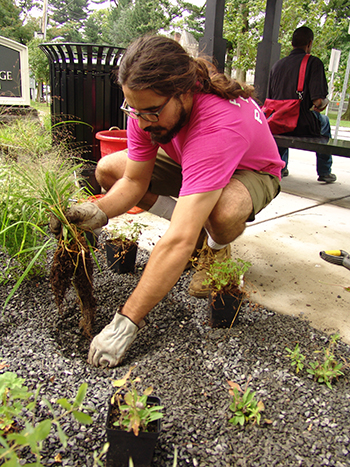
It sounds harsh, but each plant gets the soil removed from its roots before it’s planted. photo credit: R. Robert
Low maintenance is a major benefit of gravel culture. With the new plantings, we will water them as needed. The schedule is more frequently immediately after planting, and after a year, plants should be established enough not to need any watering except during an extreme drought. No fertilizers are added. Ideally, the planting should only need a few visits a year for possible weeding, and a cut back in the fall or winter to prevent debris from breaking down into soil for weed seeds to grow in.
Give gravel gardening a try in your sunny spot.





Jed Johnson
Posted at 09:59h, 31 AugustGreat article – Thanks!
What plants would be recommended for filler, companion, and structural to go along with the Geranium cantabrigense ‘Karmina’, Ruellia humilis, Eragrostis spectabilis, and Asclepias tuberosa.
Thanks Again!
Becky Robert
Posted at 15:02h, 25 SeptemberDear Jed,
Below you will find a list of the other plants in this specific formula. These are all great plants but there are many more that can be used and it would be great to experiment with other perennials that you might think would work.
Structural plants: Panicum virgatum ‘Hot Red’, Baptisia ‘Lemon Meringue’, Amsonia hubrictii, Schizacharium scoparium ‘Blue Heaven’
Companion plants: Aster oblongifolia ‘October Skies’, Pycnanthemum flexuosum, Salvia nemorosa ‘Blauhugel’, Salvia nemorosa ‘Caradonna’, Liatris aspera
Filler plants: Coreopsis verticillata ‘Zagreb’, Dalea purpurea, Geranium macrorrhizum ‘Lohfelden’ or ‘Ingwersen’s Variety’, Stachys officinalis ‘Hummelo’
Susan Quinn
Jen Pfluger
Posted at 14:03h, 31 AugustThank you for the continued commentary on this intriguing style of planting, including that the PNC Bank environs hasn’t been faring well due to construction and not the planting style itself. Is there any demonstarted success with gravel gardening in older planting strips between streets and sidewalks, i.e. part sun conditions with mature trees and roots to be careful around, or is the gravel approach only recommended for new/young beds?
Becky Robert
Posted at 13:22h, 04 SeptemberDear Jeff,
At this time, our oldest gravel planting is the Roundabout garden. We experimenting with this new technique and do not have experience with part sun with mature trees situations. Our exploration of this type of gardening is based off the recommendations and experiences in German gardens by Cassian Schmidt.
Sincerely,
Becky
Peter
Posted at 09:25h, 14 FebruaryNice article, I’m also gardening from last 15 years.
Charles Hover
Posted at 03:05h, 06 JulyHi Susan Quinn,
Thanks for sharing this article!
It is awesome!
Becky Robert
Posted at 10:02h, 09 JulyThank you Charles!
I am glad you enjoyed the article and info.
Sincerely,
Becky Robert
Scott Arboretum
Angel Clare
Posted at 13:24h, 03 JanuaryI am planing to start a gravel garden. Your article has provided me with an awesome formula. I will apply it. Thanks!
Becky Robert
Posted at 09:05h, 06 JanuaryDear Angel, I am glad you found the info useful. Good luck on your project.
Happy New year,
Becky
Scott Arboretum
Inge Daniels
Posted at 07:37h, 11 JuneThanks for this interesting step-by-step article. I would not have thought to remove soil from the rootball but that makes great sense. Any thoughts on gravel types? Looks like 3/8″ stone?
Patricia Griffin
Posted at 12:42h, 25 FebruaryHello, thank you for your article. It has given me hope. We have an area under a deck which we had cleared out and 4-5” of pea gravel poured as we planned for a gravel garden.
So far we have only seen plants that do well in full sun recommended for this area and we have from partial sun to shade in this area. Do you have any suggestions for planting? This is a new development (we downsized) without much land and we are desperate to garden even in stones.
Thanks!
Becky Robert
Posted at 09:10h, 01 MarchGood morning,
Without being familiar with the site in regard to light, soil conditions, plant preferences, etc. it is challenging to formulate a list of suggested plants.
If the soil has not been amended with gravel I would venture to say that any full shade to partial shade plant that prefers the particular soil composition in the area intended to be planted would do well with gravel as a mulch.
Are you primarily interested in perennials or shrubs or a mix?
Generally speaking ground cover type plants prefer to have direct root access to mulch or soil. As a result these types of plants with some exceptions do not favor the gravel culture environment.
If the conditions are rather dry there are many plant lists online that can be accessed by performing a simple google search.
Best,
Adam Glas
Garden Supervisor